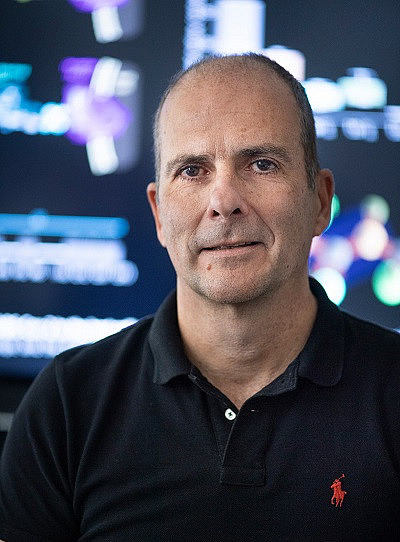Condensed Matter Physics and Ultrafast Phenomena
1) Simulation of fast and ultrafast structural changes in solids and nanostructures
The interaction of intense femtosecond laser pulses with solids gives rise to a variety of exciting new phenomena, that are initiated by the fact that electrons can rapidly be heated up to temperatures of several ten thousand Kelvin, i.e., far above the temperature at the surface of the sun. The resulting transient nonequilibrium state drives ultrafast structural phase transitions in different materials along pathways that are inaccessible under thermodynamic conditions. The group focusses both on the ultrafast lattice dynamics during the first picoseconds after excitation, on which mainly nonthermal bond-breaking effects occur, as well as also on the longer time scale (up to hundreds of nanoseconds), on which mechanical stress relaxation and ablation take place. In the last years, the group has achieved important results in both time-scales:
K-space image for ultrafast melting of silicon
With the help of ab-initio simulations performed using our code CHIVES (Code for Highly excited Valence Electron Systems) we have shown that the energy redistribution among the ions of silicon immediately after femtosecond laser pulse excitation proceeds in a highly anisotropic way. Interestingly, the direction in which ions disorder during the nonthermal melting process changes for increasing laser fluences and is not necessarily related to the vectors in k-space where lattice instabilities upon laser excitation occur [1].
Large-scale simulations of laser nanostructuring of metallic surfaces
The mechanism of surface restructuring by ultrashort laser pulses involves a number of fast nonequilibrium and interrelated processes while the solid is in a transient state. As a result, the analysis of the experimental data cannot address all of the mechanisms of nanostructuring. In collaboration with the Laserlaboratorium Göttingen we achieved a direct comparison of simulation experimental results of surface nanomodifications induced by a single laser pulse. The experimental results were obtained by using two UV-beam interference, thus producing a large-area intensity grating of 40 μm in diameter on a gold surface with a sinusoidal shape and a period of 500 nm. The simulations were based on a hybrid atomistic-continuum model capable of capturing the essential mechanisms responsible for the nanostructuring process [2].

Figure. 1: Atomic snapshot configuration of a Au- film irradiated with a 1.6-ps UV-laser pulse with incident fluence of 145.9 mJ=cm2. Atoms are colored according to their central symmetry parameter (CSP) for identifying solid (blue), liquid (green), defects (light blue), surface (light green), and free (volatile) atoms (red). The 3D view of the atomic configuration in the rectangle area shows the formed voids (b).
The very good agreement between the modeling results and the experimental data justifies the proposed approach as a powerful tool revealing the physics behind the nanostructuring process at a gold surface and providing a microscopic insight into the dynamics of the structuring processes of metals in general. The presented model constitutes an important step towards a computational tool for predicting a materials response to an ultrashort laser pulse on the atomic scale [2].
2) Nonequilibrium Markov-State-Modeling of the influence of microwave radiation on proteins
In the framework of a collaboration with Marcus Weber (Zuse Institute Berlin), a generalization of Markov-State-Modeling (MSM) for non-reversible systems was achieved, which will possibly constitute a breakthrough in the simulation of biomolecules outside of thermodynamical equilibrium. With the help of MSM we found that, under the influence of microwave radiation of realistic intensity, different secondary structures are favored as in the absence of external fields [3]. Our results are to our knowledge the first ones to show appreciable conformational changes for field intensities of biological relevance. Previous computational studies could only show significant changes for unrealistically high field intensities.
3) Multiscale computational analysis of long-term recordings of the cockroach circadian clock
Circadian rhythms are of prime importance in driving behavior and physiology in humans and animals. A group of neurons in the brain (the clock) is responsible for this ~24h rhythm, by individually generating it within each cell and coordinating their output via network interactions. How cells interact and achieve synchronization the clock is still a central question. To address this fundamental problem, we collaborated with Prof. Monika Stengl and Prof. Hanspeter Herzel (Humboldt University of Berlin). We developed a method, based on wavelets, to analyze long term in-vivo electrophysiological recordings and applied it to loose-patch clamp experimental data from the cockroach circadian clock [4]. A major challenge in this task comes from the widely separated timescales involved between the fastest neural electric pulses (milliseconds) and the circadian timescale. Our method combines advanced signal processing and classification techniques to reduce the complexity of datasets, and enables a description in terms of the time evolution of parameters that are signatures of interaction and synchronization in networks. Through the analysis of many recordings from different animals, we also showed a possible link between the time-of-the-day dependence of the parameters and timed neuropeptide release in the cockroach brain [4].

References
[1] T. Zier, E. S. Zijlstra and M. E. Garcia, Quasimomentum-Space Image for Ultrafast Melting of Silicon,Phys. Rev. Lett. 116, 153901 (2016).
[2] D.S. Ivanov, V.P. Lipp, A. Blumenstein, F. Kleinwort, V.P. Veiko, E. Yakovlev, V. Roddatis, M.E. Garcia, B. Rethfeld, J. Ihlemann, and P. Simon, Experimental and Theoretical Investigation of Periodic Nanostructuring of Au with Ultrashort UV Laser Pulses near the Damage Threshold, Phys. Rev. Applied 4, 064006 (2015).
[3] B. Reuter, M. Weber, K. Fackeldey, S. Röblitzand M. E. Garcia, Generalized Markov State Modeling method for non-equilibrium biomolecular dynamics - exemplified on peptide conformational dynamics driven by an oscillating field, J. Chem. Theory Comput. 14 (7), 3579–3594 (2018).
[4] Pablo Rojas, Jenny A. Plath, Julia Gestrich, Bharath Ananthasubramaniam, Martin E. Garcia, Hanspeter Herzel and Monika Stengl, Beyond spikes: Multiscale computational analysis of in vivo long-term recordings in the cockroach circadian clock, Network Neuroscience 3, 944-968 (2019).
Prof. Dr. Martin E. Garcia
full member

- Location
- Universität Kassel
Fachbereich 10 - Naturwissenschaften & Mathematik
Institut für Physik
Heinrich-Plett-Straße 40
34132 Kassel
- Room
- 1279
